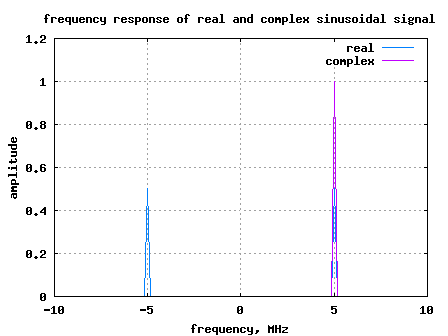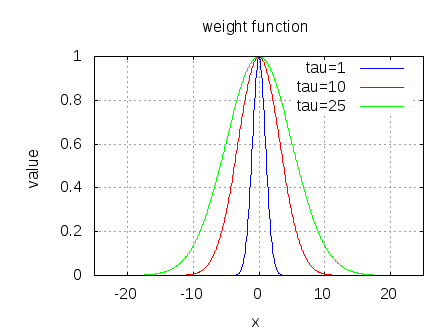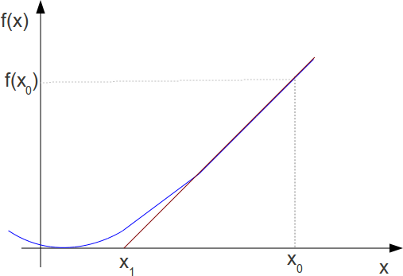Last week, I received an email from Mr. Kishore. He was wondering about the physical significance of negative frequency. Does negative frequency really exist?
Though I have seen conflicting views on the net (thread in complextoreal.com, thread in comp.dsp), my perspective is that negative frequency exist. The concept of negative frequency helps me a lot to understand single sideband modulation (SSB), OFDM systems, I Q modulators etc (to name a few).
Simple explanation for negative frequency
The wiki entry on negative frequency provides a simple explanation using as an example.
We know that . This means the sign of
cannot be un-ambiguously found out from observing
alone. This implies that it is reasonable to think that
has frequency components at both
and
.
Similarly, this ambiguity exists for too.
Negative frequency using Taylor’s series expansion
Thanks to the nice paper by Mr. Richard Lyons, Quadrature Signals: Complex but not Complicated, Richard Lyons.
Let us first define the magic number and so on.
The Taylor series expansion of ,
and
are as follows.
Let us now define the Taylor series expansion of .
.
Similarly,
.
Combining the above two equations, one may write
.
If we apply , then we get,
and
.
This forms the proof that a real sinusoidal having frequency is comprised of a complex sinusoidal having a positive frequency at
and a negative frequency at
.
Simple Matlab example for Negative frequency
Click here to download Matlab/Octave code for plotting the spectrum of real and complex sinusoidal

Figure: Spectrum plot showing positive and negative frequency
As discussed above, the real sinusoidal has frequency components at +5MHz and -5MHz where as the complex sinusoidal has frequency component only at +5MHz.
Negative frequency in OFDM
Some of you might be familiar with the IEEE 802.11a specification where subcarriers from [-26 to -1 and [+1 to 26] are used. The subcarriers -26 to -1 corresponds to usage of negative frequency and lets try to understand it.
The equation for an OFDM transmission is,
,
where
(a) correspond to the frequency of the sinusoidal and
(b) is a rectangular window over
(c) is the symbol period.
(d) each information signal is modulated on to a complex sinusoidal having frequency of
.
(e) Sum of all such modulated sinusoidals are added and the resultant signal is sent out as .
In the IEEE 802.11a specification, symbol duration is 3.2
, sampling frequency
is 20MHz and
.
The frequencies used for modulating the ‘s are
,
,
,
and so on till
. Expressing in Hz, this corresponds to frequencies from 0Hz, 312.5kHz, 625kHz, 937.5kHz, 1.25MHz,…, 10MHz, 10.3125MHz,… till 19.6875MHz.
From our understanding of sampling theory, we know that with a sampling frequency of , we can only see frequencies from
to
.
Note: The frequency is called the Nyquist frequency.
So in our 802.11a example, what will happen to frequencies which are modulated on subcarriers lying from 10MHz till 19.6875MHz?
Quick answer: They get folded! 😉
The frequencies from 10MHz till 19.6875MHz gets folded and seems as if they are lying from -10MHz to -312.5kHz.

Figure: Spectrum folding to negative frequency in IEEE802.11a specification
Further, folding of the spectrum to the negative frequency region does not cause any problems. Reason: ‘s which where modulated on complex sinusoidals having frequencies from 0 till 10MHz did not have any negative frequency component.
Note:
In general, one can say if a sinusoidal is of frequencyThe concept of folding is well explained in Chapter 1.4.1 of [DSP: PROAKIS]. A simple example of folding which we may see in our day to day life is with a ceiling fan. One may see that the blades of the fan are rotating at a slower speed in a direction opposite to the actual rotation of the fan blades. Needless to say that the sampling frequency of our eye’s are not good enough. 🙂
Happy learning.
Reference
[DSP: PROAKIS]: Digital Signal Processing, John G. Proakis
Quadrature Signals: Complex but not Complicated, Richard Lyons



Dear Shankar Anna,
As you explained about negative frequency in the blog can we make the sense that the negative frequency is the frequency below the center frequency and the positive frequency is the frequency above the center frequency in the bandwidth of frequencies. whether my understanding is correct? if so then if there is a single frequency how can we understand the negative frequency.kindly reply me.
thanks in advance
with regards
Arunpradhap Natarajan
@Arunpradhap: Well, that is one way of understanding. The sign of the phase is also a pointer
what is the bandwidth of signal existing between the frequencies -fm to +fm?
@amu: … 2fm. but, why?
hello sir…..
i am doing my project on “Peak-to-Average Power Ratio Reduction of OFDM Signals Using PTS Scheme With Low Computational Complexity”…so could you please help me out by providing the complete matlab code………
@shyamala: sorry, I do not have relevant Matlab codes handy
Hello. Thought I could add something on negative frequency. Since Sinusoids (Cosine and Sine) are projections of rotational motions of complex exponentials , Negative frequency can be interpreted as a rotational motion in anti-clock wise direction .
@Shankar: Thanks
Is there any effect of -ve frequecy on Bandwidh ?
if yes then why ?
if no then why ?
@SHOAIB REHMAN SOOMRO: If the information on +ve and -ve frequency are different, we need to send the whole chunk of spectrum. If you recall, there were single side band techniques where one half of the spectra was shaved off (as the information in the -ve half was redundant)
Dear Krishna,
How do you justify the beating affect when you multiply two waves together, sums and differences of the two frequencies will be generated.
In Amplitude modulation, the negative freq. doesn’t jump into the positive freq axis to become Lower Side Band. It is the difference frequency components from the beating affect that causes it. The negative frequency component doesn’t exist in physical sense.
BUT, if I try to explain the modulation process with the help of convolution, the negative part does play the role to become one of the sidebands. I AM CONFUSED!!!
please help!
@Subzero: Sorry, I did not understand your comment well enough to give a meaningful reply.
if i say that spectrum is between -f and f,then does it mean that power in the spectrum will be distributed equally on both sides?
@vivek: The power of the spectrum at +ve and -ve need not necessarily be the same
Hi Mr Krishna Sankar!
I know that Negative frequencies exist but I just have a question: why negative frequencies are needed in the spectrum?
@Kokulan: The negative frequencies helps us to understand, for example, IQ modulation.
inputiFFT(subcarrierIndex+nFFTSize/2+1) = ipMod(ii,:);
how does the above expression work? what is the use of : (colon) ?
why do we have to use the following expression?
–subcarrierIndex+nFFTSize/2+1
And please let me know
how the cyclic prefix has been done?
@vedika:
1. For each row ii, am assigning all columns of ipMod to the variable inputiFFT per the indexing subcarrierIndex+nFFTSize/2+1
2. For inserting cyclic prefix, we take the last 16 samples from the ifft output and pad it to the same variable again.
% adding cyclic prefix of 16 samples
outputiFFT_with_CP = [outputiFFT(49:64) outputiFFT];
just we know the concept of -ve frequency is sometimes used to distinguish a decreasing angle from an increasing one why we need the negative frequencies in fourier transforms
@pulkit: Sorry, was that a question or a statement?
All the events in the real world are real but frequently an easly mathematical description may be gived using mathematical entity like complex numers.
For example a modulation like M-PSK is realized like a superposition of two real signals (sin plus cosine) but rather than use in your formulas two (real) numbers you may compact your notation using a single complex number and is implied to take the real part.
The link between real and complex trigonometric functions is gived from the eulero formula.This formula say that cos(x)=(1/2)[exp(ix)+exp(-ix)] and sin(x)=(1/2i)[exp(ix)-exp(-ix)].
Using the various theorems about Fourier trasforms every function with finite Fourier integral are descriptable like a super position of sin and cos of opportune amplitude, frequency and fase.
So the negative frequency component is pureli a collateral effect of the complex description.
@Sergio: So, are you saying that negative frequency is a mathematical notion? However, I think negative frequency do exisit (as -ve numbers do exist) :).
@Arturo: Thanks for the close review. I corrected the equation. 🙂
A minor typo, after the line: “Combining the above two equations, one may write”; the sine equations must have a minus sign instead of a plus sign when the sine is expressed as the addition of the two exponentials